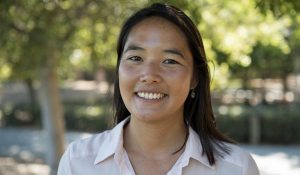
Miyuki Hino is an assistant professor in the department of city and regional planning and an adjunct assistant professor in the environment, ecology and energy program at The University of North Carolina at Chapel Hill. Her research examines the linkages between climate hazards, governance and public policy to drive effective and equitable adaptation to climate change. Recent work has focused on the impacts of sea level rise, the effects of flood risk on property markets and the use of managed retreat in adapting to climate change. Hino received a PhD in environment and resources from Stanford University and a BS in chemical engineering from Yale University.
“We are still building homes in floodplains and in fire zones and in places exposed to other types of natural hazards, and I worry a lot that we are creating future trapped households.”
Tell us about your ongoing research.
I work on increasing community resilience to the impacts of climate change. Part of my work is about measuring how climate change affects different social and economic outcomes. As floods become more frequent or wildfires become more destructive, how does that affect local businesses? How does that affect real estate markets?
The other half of my work is about enabling adaptation to climate change that is both efficient and equitable. In some sense, we have a real advantage in that we know that climate change is coming. We know to expect stronger hurricanes and more frequent heat waves in the future, so we can prepare for them. In my research, I identify the policies and programs that have effectively reduced the impacts of these types of events before. If we can adopt these practices and implement them more broadly, we can reduce the impacts of climate change – hurricanes in the future won’t cause as much damage as they might’ve otherwise.
 Some of my ongoing work looks specifically at households that live in really flood prone places – and how we can help them move to safer places. We have a bit of experience with this in the US through a federal program that will purchase people’s homes after floods and restore them to open space – basically determining that that particular plot of land is just too risky or too hazardous for people to live on. But we know that the risks are growing rapidly, so there’s real urgency to better understand which households would benefit from that type of intervention and to understand how to design that program to really make sure that the households are safer and better off once they’ve moved and left that very flood-prone place.
Some of my ongoing work looks specifically at households that live in really flood prone places – and how we can help them move to safer places. We have a bit of experience with this in the US through a federal program that will purchase people’s homes after floods and restore them to open space – basically determining that that particular plot of land is just too risky or too hazardous for people to live on. But we know that the risks are growing rapidly, so there’s real urgency to better understand which households would benefit from that type of intervention and to understand how to design that program to really make sure that the households are safer and better off once they’ve moved and left that very flood-prone place.
What has been most surprising about what you’ve found so far?
When I first started doing this work, I wasn’t sure if there would be very many households that wanted to move in the first place, because people love where they live. People are really attached to the places where they live for good reason, and so I had thought that there would only be a handful of houses where the flooding was so bad that they would actually want to move away and get out. I’ve been really surprised, following this, that there is so much demand, that after every storm you see stories come out from households who have flooded five times in eight years or eight times in ten years, and they really want to leave. But they can’t, maybe because nobody would buy their house, or because they could sell their house, but the amount they would get for it wouldn’t be enough for them to live anywhere close by. So one thing that surprised me and motivated me is that there is real demand out there for help. There are people that are sort of trapped in these challenging situations, and there’s an opportunity to help them by figuring out solutions to support them in moving to safer ground.
What do you hope to learn in the next stage of your research?

In the next stages of my research, what I’m focusing on is how to prevent this type of situation from arising in the first place. We are still building homes in floodplains and in fire zones and in places exposed to other types of natural hazards, and I worry a lot that we are creating future trapped households. We’re creating a situation where a household is very happy to live there now, but in 10 years or 30 years, maybe they want to get out because they’ve had too much experience with these types of extreme weather events. Part of the puzzle is to understand how to effectively manage these types of hazardous places so that communities can use and benefit from their land and resources – but at the same time, they’re building and growing in a way that’s safe and resilient to climate change, and ultimately that’s sustainable for the long term.